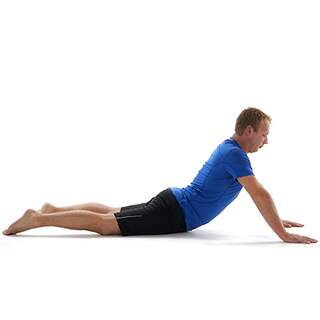Lower back pain is a frequent complaint among runners, affecting up to 20% of athletes. While running offers cardiovascular benefits and stress relief, improper form, weak muscles, or inadequate gear can strain the lumbar spine. This guide combines expert insights with actionable strategies to help runners prevent and manage discomfort.
Why Do Runners Develop Lower Back Pain?
Traditionally lower back pain was associated with manual heavy work or lifting a heavy box at home, and this can still be a cause. However, nowadays in the modern world, our more sedentary work and lifestyles can be as much of a contributory factor; have you sat at your computer all day, driven home then gone straight out for a run? It’s easy for your lower back to stiffen up and become painful when you go from one extreme to the other.
A change in training type, volume or intensity can have an effect on your body and lead to an injury. Suddenly increasing your mileage or adding some intense speed sessions to your plan may sound like a great idea but could potentially lead to injury. Always be careful when making sudden changes to your training plan.
Common triggers include:
- Overexertion → Rapidly increasing mileage or intensity without proper conditioning.
- Weak Core Muscles → Insufficient strength in abdominals, obliques, or glutes forces the lower back to compensate.
- Poor Posture → Leaning too far forward/backward or rotating the torso excessively while running.
- Inappropriate Footwear → Worn-out shoes or models lacking arch/heel support.
- Joint Stiffness → Limited mobility in hips or hamstrings increases lumbar strain
What should I do?
1. Firstly don’t panic, stay calm and seek the advice and treatment of a chartered physiotherapist.
2. Try some gentle stretches and exercises like these to ease the pain:








3. Stay mobile, change position regularly, particularly if you work at a desk.
4. Try some basic core and postural work.
5 Proven Strategies to Prevent Pain
Build Core Stability
A strong core is fundamental for runners aiming to prevent lower back pain. The muscles of your abdomen, obliques, glutes, and lower back create a stabilising belt for your spine, absorbing impact and helping you maintain proper posture throughout your run. By regularly incorporating core-strengthening exercises such as dead bugs, bird dogs, and side planks into your weekly routine, you’ll notice improved stability and less strain on your lower back. Over time, a well-conditioned core not only reduces the risk of injury but also enhances your overall running efficiency, allowing you to run further and faster with greater comfort.
Optimise Running Form
Proper running form is a game-changer when it comes to protecting your lower back. Focus on keeping your posture upright, with your ears aligned over your shoulders and your shoulders over your hips. Avoid leaning too far forward or backward, as this can increase the load on your lumbar spine. Maintaining a consistent cadence—ideally between 170 and 180 steps per minute—helps minimise the impact on your joints and back. Additionally, aim for a midfoot strike rather than landing heavily on your heels, as this distributes impact forces more evenly and reduces the risk of discomfort or injury.
Choose Supportive Gear
The gear you choose, especially your running shoes, plays a significant role in preventing lower back pain. Shoes that offer adequate cushioning and support help absorb shock and keep your body aligned as you move. It’s important to replace your running shoes every 300 to 500 miles, as worn-out footwear can lose their supportive qualities and increase your risk of pain. Consider brands known for their support, and don’t hesitate to seek a professional gait analysis to find the perfect fit. For some runners, custom orthotics or compression shorts can offer additional stability, particularly on longer runs or when recovering from previous injuries.
Modify Training Surfaces
Where you run can have a big impact on your lower back health. Hard surfaces like concrete tend to amplify the forces transmitted through your body, potentially leading to discomfort or injury. Whenever possible, opt for softer terrains such as grass, woodland trails, or synthetic running tracks, which provide better shock absorption. If you prefer treadmill running, setting a slight incline can help mimic outdoor conditions and reduce strain on your lower back, making your workouts both safer and more enjoyable.
Prioritise Recovery Protocols
Recovery is just as important as training when it comes to preventing lower back pain. After your run, take time to stretch the key muscle groups that support your back, including the hamstrings, glutes, and hip flexors. Incorporating foam rolling into your routine can help release muscle tension and improve flexibility. Cross-training with low-impact activities like swimming, cycling, or yoga gives your back a break from repetitive impact while still building strength and endurance. By making recovery a consistent part of your routine, you’ll help your muscles repair and grow stronger, ensuring your lower back stays healthy and pain-free for the long run.
FAQs
Mild soreness may resolve with rest. Sharp or radiating pain warrants medical evaluation.
A: Dehydration reduces disc elasticity. Drink 500ml water 2 hours pre-run.
Temporary support yes, but over-reliance can weaken core muscles long-term.
Lower back pain in runners is often caused by muscle strain, poor core strength, muscle imbalances, improper running form, sudden increases in mileage, running on hard surfaces, and wearing unsupportive or worn-out shoes.
Prevention strategies include strengthening your core, improving running posture, gradually increasing mileage, warming up properly, wearing supportive footwear, and varying running surfaces to reduce impact on the spine.
Choose running shoes with good cushioning and arch support. Replace shoes every 300–500 miles, and consider a gait analysis to find the best fit for your running style and foot shape.
Related Articles








